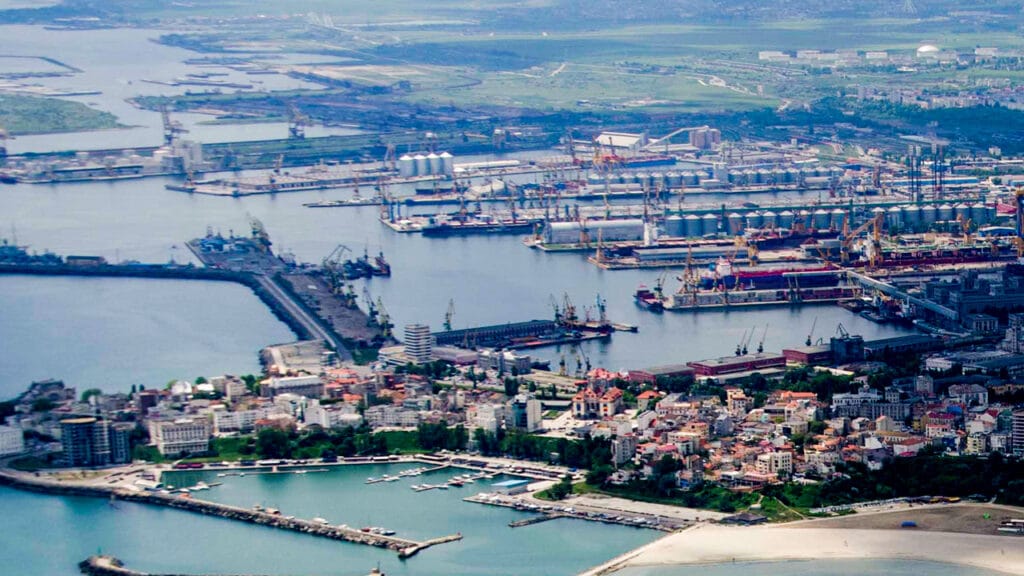Constanta, Romania (PortSEurope) November 2, 2022 – The Ukrainian Danube Shipping Company (UDP) has agreed with the Romanian group of companies TTS (Transport Trade Services) on transshipment of Ukrainian grain exports through Romania’s Black Sea port of port of Constanta, TTS said.
The Danube Grain Route project provides a safe and guaranteed delivery of agricultural products from Ukrainian river ports to a large-tonnage sea vessel in Constanta. The average caravan turnaround time will be reduced by about 30%.
It is planned to equip ships with online control systems; video surveillance; and increase the number of navigators in the crew. In the future a barge caravan will be able to make up to two trips per month.
In a second stage of the project, it is planned to build new barges and modernize the self-propelled fleet with the replacement of engines.
Russia’s actions
Russia has unilaterally blocked on October 29 the United Nations-brokered deal allowing Ukrainian grain exports from its ports. This follows alleged drones attacks on Russian navy ships in Sevastopol. It is the biggest city in Crimea, part of Ukraine annexed by Russia in 2014. It is also home to Russian Black Sea navy.
At the start of the Russian invasion last February, all Ukrainian seaports were blocked by the Russian navy, ending all exports. In a successful attempt to restart food exports, Ukraine worked with Romania to set up inland waterways. Road and rail transport also started,
The United Nations’ Black Sea Grain Initiative Joint Coordination Centre is the result of an agreement between the UN, Turkey, Ukraine and Russia. It permits commercial food exports from three key Ukrainian ports in the Black Sea – Odessa, Chornomorsk and Yuzhny. Ukrainian grain shipments are key to world food supplies.
Under the July 22, 2022, agreement, Ukraine was able to restart its Black Sea grain and fertilizer exports, blocked since Russian invasion. The Ukraine export deal was initially agreed to last until mid-November.
Danube
A lot of the grain exports are via the Ukrainian Danube ports of Izmail, Reni and Ust-Dunaisk. This has involved working with Moldova to utilise canals and other inland waterways, with some cargo eventually reaching Romanian Black Sea port of Constanta.
These routes are still being used even after the U.N-sponsored maritime corridor started in August. This allows grain exports from ports in Odessa under agreed conditions. Additional grain are exported via road and railways to Poland and Romania.
TTS distinguishes itself through the multimodal approach of services offered: river/maritime and land transport of bulk and packed commodities goods, handling of goods and equipment in Danube ports and Constanta, as well as door to door transportation. Operating with its own assets plays a key role for TTS in providing efficiency and flexibility of service.
The first vessel with Ukrainian grain left the port of Odessa on August 1. Up until end-October, more than 9.8 million tonnes of food has been exported through the Black Sea, according to the UN. In September, Ukraine exported 4 million tonnes of food through the Black Sea. Before Russia’s invasion, Ukraine was shipping 5 million tonnes every month.
Three more vessels left Ukrainian ports on November 1, the UN-led centre co-ordinating the Black Sea grain export deal said, despite a Russian decision to suspend its backing of the scheme.
The centre said the ships’ movement had been agreed by Ukraine, Turkey and the UN, while Russia “has been informed”. On October 31, 12 ships carrying 354,500 tonnes of food sailed from Ukraine.
More PortSEurope news about Ukrainian grain
Copyright (C) PortSEurope. All Rights Reserved. 2022.

